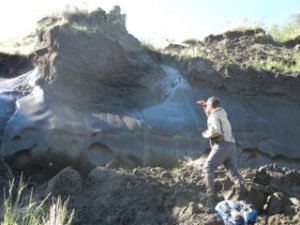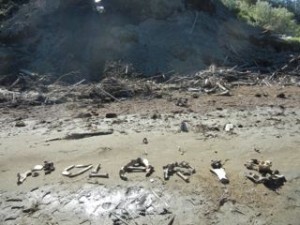“Are you fired up?!” Andy yells, his voice cutting through the wind. It’s a clear, breezy morning, and the Core group is gathered on the mucky banks of Duvaniy Yar, an area along the Kolyma known for its outcroppings of exposed permafrost and its rich deposits of megafauna bones. With all the pep talk, it feels more like a pre-game huddle at a basketball game than a field trip back in time to the Pleistocene. John soon joins in the melee. “Come on, can’t you just see the mammoths?” he shouts, followed by a chorus of responses: “I see them!” “I seem them!”
All the hype was warranted—it’s a spectacular place. Steep embankments cut down to the Kolyma River, cascading into a bank of dangerously thick mud and leaving swatches of grassy vegetation and huge chunks of exposed permafrost in the process. We’ve talked and read a lot about ice wedges, and we could finally see them: big, oblong, and melting, with the occasional cluster of 30,000 year old roots protruding out from the soil.
The permafrost, and the carbon it contains, is ancient (20,000 to 40,000 years old, to be precise). During that time, the ecosystem supported a dynamic community of megafauna: horses, bison, muskoxen, elk, and, everyone’s favorite, mammoths. They lived in the grassy tundra steppe until man hunted them to extinction. Larch forests soon replaced most of the grass, and the animal bones are one of the few visible parts of the era that are left. The rest is left to the imagination.
Walking along the banks littered with downed trees, we spent hours hunting for bones, and we were rewarded with a bounty of fist-sized vertebrae, smooth, tubular clavicles, and club-like femurs. One of the best finds of the day was an enormous mammoth tooth. We were all impressed, but Nikita, having hunted bones since he was a kid, told us that it was probably “just a teenage mammoth.”
It was a long trek to get here, though short when you consider we basically traveled through an entire geologic era. We bid the Holocene goodbye on Wednesday night, then boarded the barge for a cruise along the Kolyma at a pleasantly glacial pace. A trip that would’ve taken only a few hours in a motorboat took 16 hours on the much bigger barge. It’s a really exciting mode of travel, though, and the time flew by. Picture an RV with pontoons, filled with good food, comfortable bunks, and musically gifted ecologists. In between project planning, we passed evenings listening to repeated choruses of “Wagon Wheel” and mornings sipping coffee on the screen porch.
Field trip over, we’re now headed back to the NESS to begin our projects in earnest. We’ve carefully and painstakingly planned them out, but, as always happens, plans will probably change, and we’ll probably adapt. In the meantime, we’re enjoying a rickety ride along an unsettled Kolyma. Only a few bottles of bug spray and bars of chocolate have fallen from the shelves onto my head as we lurch through the choppy waves. I can only hope that these waves will mellow and rock me to bed, with visions of mammoths dancing in my head.
- We got a little creative with the megafauna bones






Comment(1)-
Veronica Alston says
July 16, 2013 at 9:42 pmWOW! Those bones are really amazing. Also sounds like a beautiful place, worth the hike.